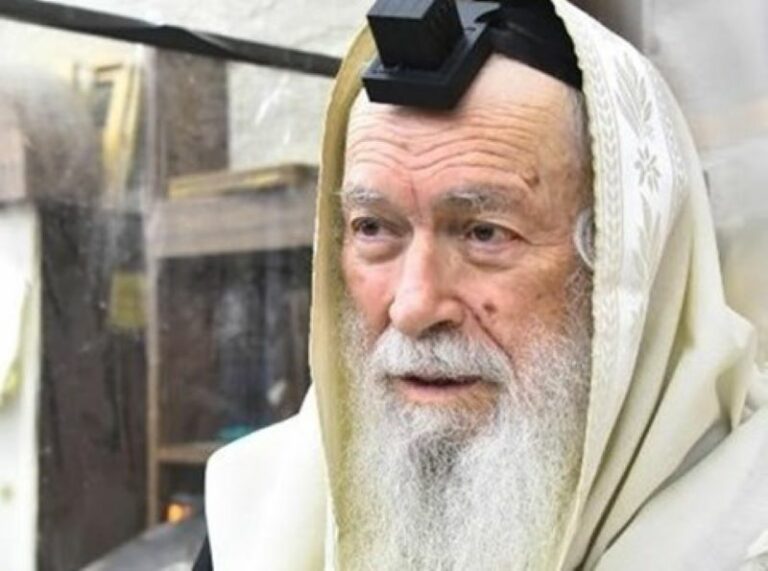
R’ Meir Klein of Boro Park, an “ehrliche yid”, readies himself every Elul for the upcoming ימים נוראים. אלול תשע”ד, R’ Meir found himself preparing his טלית שבת for the weeks ahead. Noting that the lining was worn out, he gave it to a popular cleaners on 14th Avenue in the center of Boro Park. They replaced the lining for a minimal fee. He then wore his טלית, davening for a good new year.
A few months later, in the winter of תשע”ה, R’ Meir Klein’s brother R’ Yosef, also of Boro Park, considered relining his טלית as the lining was worn out as well. However, R’ Yosef was very hesitant to have the relining done at the same cleaners. Since the establishment was owned by a non-Jew, something seemed inherently wrong about trusting their repair work. He asked his friends and family if he should be stringent and not have the repair work done at that cleaners and was told not to be childish as, “everyone uses that cleaners!”
As most authorities are lenient in regard to having one’s טלית cleaned by a non-Jew, and because the cost was significantly cheaper than other cleaners, R’ Yosef capitulated and had his טלית cleaned and relined at the same cleaners that his brother had his done.
Little did he realize, that in regard to repairing or making a garment, the Halacha is much more stringent due to the חשש of שעטנז.
When R’ Yosef wore his refurbished טלית for the first time on Shabbos, strangely, he felt that the טלית was somehow different. This would be a Shabbos for him to remember! Something wasn’t right and R’ Yosef could not quite pinpoint it.
Luckily for him, his brother-in-law, a Vishnitzer Chosid, was visiting him for Shabbos and told him that if it feels “different” it may be a question of שעטנז. R’ Yosef was shocked to hear of such a possibility. Growing up in the Boro Park neighborhood of Brooklyn, where men purchase their garments at “heimishe” outlets, he had no real knowledge about any potential שעטנז problems.
R’ Yosef then recalled that he had seen a שעטנז alert from Vaad L’Mishmeres Shatnez regarding shatnez that was found in a certain brand of children’s hats sold in a heimishe store. He decided then and there to stop wearing the טלית until he could clarify the matter.
R’ Yosef then went on to make his own investigation.
First he went to the cleaners that added the lining. He asked the non-Jewish owner if he could see the label of the fabric used for the lining of his טלית. The owner said that he didn’t have the label anymore. When R’ Yosef prodded the owner as to what it was made of, the owner told R’ Yosef that he always bought the cheapest fabric. (This may explain partly why they had cheap prices. He charged $10 to reline a טלית while other places in Boro Park charge around $50.)
The owner then told him that he believed that the lining material was made of cotton, but was not sure.
For the first time in his life, R’ Yosef went directly to the Shatnez Laboratory of Boro Park only to find it closed! Due to the lack of public concern for shatnez, the laboratory has limited hours. Friday, the day that R’ Yosef visited the laboratory, it was closed.
R’ Yosef’s tension about having possibly worn shatnez was immeasurable.
The following week, the Shatnez Laboratory of Boro Park was called. Rabbi Yaakov Gurwitz, the director of the laboratory, declared that שעטנז is indeed prevalent, and that the טלית should be brought in for testing.
The טלית was brought to the Boro Park Shatnez Laboratory for testing. R’ Yaakov Gurwitz immediately discovered that the lining material was of a linen blend. In one direction the threads were linen and in the other direction they were rayon. The Talis was declared shatnez, as even one thread of linen would have made the טלית into shatnez.
R’ Yosef was shocked to learn that he had been wearing שעטנז . Never in his wildest dreams could he imagine that he would wear שעטנז ! To his great dismay, not only did he wear שעטנז, but he had also made a ברכה לבטלה on the טלית and had been considered carrying the טלית on Shabbos when he wore the טלית to and from Shul!
R’ Yosef noted that, weeks before Pesach, many give in their tablecloths to be pressed and starched at this popular cleaners. The volume of tablecloths is so high that they are unable to handle the demand. Ironically, at this very cleaning establishment he had become a victim of שעטנז.
Remarkably, R’ Yosef was able to feel that something was wrong with his טלית. Such a feeling was also felt relative recently by a yungerman in ישיבת בית התלמוד located in Bensonhurst, a Brooklyn neighborhood. This yungerman, who we will call R’ Simcha, was given a used suit, previously worn by a wealthy acquaintance. When he davened while wearing it for the first time, he felt that his davening wasn’t “going”.
R’ Simcha remembered hearing a story of a bachur in the Mirrer Yeshiva in Shanghai. On Yom Kippur this bachur felt that his davening wasn’t “going”. He ran out in the middle of davening to change his suit because he felt that he must have been wearing שעטנז. As the ספרים say, when someone is wearing שעטנז his תפלות are not accepted. This bachur’s suit was verified to be שעטנז.
R’ Simcha took his suit to the Flatbush Shatnez Laboratory who verified that it was שעטנז.
R’ Yosef Klein’s brother, R’ Meir, who had been wearing his relined טלית for a couple of months, was told of the developments. R’ Meir feared the worst. The linings of the two טליתים were identical in appearances and R’ Meir was convinced that his טלית too had שעטנז. He was compelled to write the word שעטנז in large with a marker on his טלית, as seen in the above picture. That would assure him that he would not wear it.
 Unfortunately, R’ Meir’s fears were realized! His טלית was sent to the headquarters of the Organization of Professional Shatnez Laboratories, located in Lakewood, New Jersey, where the Director, Rabbi Yosef Sayagh, confirmed that the טלית was indeed שעטנז! (See picture above.)
Unfortunately, R’ Meir’s fears were realized! His טלית was sent to the headquarters of the Organization of Professional Shatnez Laboratories, located in Lakewood, New Jersey, where the Director, Rabbi Yosef Sayagh, confirmed that the טלית was indeed שעטנז! (See picture above.)
The problem with שעטנז in Boro Park is not limited to טליתים. A Jewish owned store in Boro Park had been selling שעטנז children’s hats for a few years. Woolen sweaters have also been sold שעטנז, as well as many other incidents.
There are many lessons to be learned from these unfortunate episodes.
One lesson is, that even today we have among us people who can “feel” when they are wearing שעטנז. They are obviously on higher spiritual level.
Another lesson is, that even these very spiritual people, can fall victim to wearing שעטנז.
Another lesson is, that linen can be both a prevalent and cheap fiber.
R Yosef Klein is now on a mission to inform everyone of the real possibility of שעטנז today. The fact that “everyone” uses a certain store and cleaners, or has a certain practice, does not faze him anymore. He wants to share his new found knowledge, which came to him like a slap in the face, to possibly keep others from falling into the same trap.
With a potential problem of hundreds, if not thousands of Yidden in Boro Park wearing שעטנז garments, his task seems impossible. But R’ Yosef is not a quitter; he is a man with a mission. His mission is to inform the public, so that no one should make the tragic assumption that the מצוה of שעטנז is not relevant בזמן הזה!!
ALL NAMES HAVE BEEN CHANGED IN THIS ARTICLE TO PROTECT THE IDENTIFY OF THOSE INVOLVED

 (YWN World Headquarters – NYC)
(YWN World Headquarters – NYC)






8 Responses
Sigh. This story reminds me of those games we played as kids “how many things wrong can you find in this picture.” Reading this story actually made me a little dumber.
There’s the old joke about the cleaners owned by a Goy that did the yid a favor by taking out all of the knots in the strings that were attached on the four corners.
Doesn’t the gemara in yevamos (4) say that aseh doche lo saase that gedilim taase lecha is put next to lo silbash shatnez to tell us that the mitzvas aseh of tzitzis is doche the lo saase of shatnez?
Is this only bedieved, but lchatchila one shouldn’t rely on it?
@MitzvahMan613: I believe that Gemorah is referring to the mitzvas asei of techeilis. Ayin sham.
To #1 and #3
Purim was Last week !
from ATorahminute.com There is a story about a man who wore Tefillin for seventy years without ever having them checked. After seventy years he decided to have them checked. When they did, they discovered that the Tefillin were Pasul (ritually unfit), because a letter was missing. This meant that the Tefillin were unfit for use from the very first time he wore them.
The man was distraught and cried, because he had worn Tefillin for seventy years that were Pasul and, as if that were not bad enough, he had effectively recited a Berakha Lebatalah (blessing in vain) for seventy years. The man went to Hakham Yosef Hayyim, ‘a”h, the Ben Ish Hai and told him what happened.
The Ben Ish Hai told him that once in their city of Baghdad, The Tefillin were not square but rounded and they issued a Taqqanah (ruling) to have the problem rectified. On another occasion there was a problem with the straps of the Tefillin and a Taqqanah was issued for that also. “Can we say that for years the people never performed the commandment of Tefillin?”, asked the Ben Ish Hai. Rather, we apply the adage מחשבה טובה הקב”ה מצרפה למעשה (G-d accepts good intentions as if they were good deeds).
(See Abihem Shel Yisrael ‘Al HaTorah, Wayyera)
#3 and #4 Halacha : The beged and the Tzizis can be shatnez since that is the makeup of the mitzva but the beged itself cannot be of shatnez since it has nothing to do with the mitzva.
@Shuali: I suppose you are right. The gemara is only referring to techeiles which must be wool, but if there is no techeiles then it is efshir likayem shneiyhem and then you shouldn’t have the shatnez. Shkoyach